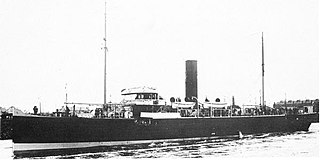
Q-ships, also known as Q-boats, decoy vessels, special service ships, or mystery ships, were heavily armed merchant ships with concealed weaponry, designed to lure submarines into making surface attacks. This gave Q-ships the chance to open fire and sink them. The use of Q-ships contributed to the abandonment of cruiser rules restricting attacks on unarmed merchant ships and to the shift to unrestricted submarine warfare in the 20th century.

USS Bonefish (SS-223) was a Gato-class submarine, the first United States Navy ship to be named for the bonefish.

USS Whale (SS-239), a Gato-class submarine, was the second ship of the United States Navy to be named for a whale, an extremely large, aquatic mammal that is fishlike in form. The USS Cachalot (SS-170) commissioned on 1 December 1933 preceded the Whale.
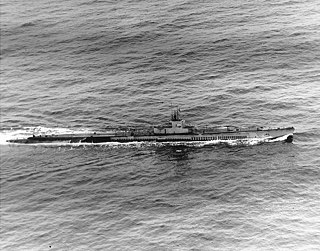
USS Tautog (SS-199), the second Tambor-class submarine, was the first ship of the United States Navy to be named for the tautog, a small edible sport fish, which is also called a blackfish. She was one of the most successful submarines of World War II. Tautog was credited with sinking 26 Japanese ships, for a total of 72,606 tons, scoring second by number of ships and eleventh by tonnage earning her the nickname "The Terrible T." Of the twelve Tambor-class submarines, she was one of only five to survive the war.

USS Tang (SS-306) was a Balao-class submarine of World War II, the first ship of the United States Navy to bear the name Tang. She was built and launched in 1943, serving until being sunk by her own torpedo off China in the Taiwan Strait on 24 October 1944.

USS Trigger (SS-237) was a Gato-class submarine, the first ship of the United States Navy to be named for the triggerfish.

USS Trout (SS-202) was the fifth Tambor-class submarine commissioned in the United States Navy, serving in the Pacific from 1941 to 1944. She received 11 battle stars for World War II service and three Presidential Unit Citations, for her second, third, and fifth war patrols. Trout also delivered ammunition to the besieged American forces on Corregidor and brought out 20 tons of gold bars and silver pesos from the Philippine currency reserve to Pearl Harbor. During 1941, she was used as a target by a series of tests determining the vulnerability of submarines to depth charge attacks.

USS Bowfin (SS/AGSS-287), is a Balao-class submarine of the United States Navy named for the bowfin fish. Since 1981, she has been open to public tours at the USS Bowfin Submarine Museum & Park in Pearl Harbor, Hawaii, next to the USS Arizona Memorial Visitor Center.

HMS Trump was a British submarine of the third group of the T class. She was built by Vickers-Armstrongs, Barrow, and launched on 25 March 1944. So far she has been the only ship of the Royal Navy (RN) to bear the name Trump. She spent the majority of her life attached to the 4th Submarine Squadron based in Australia. She was kept in service following the war and was refitted for greater underwater performance, and was the final RN submarine to be posted in Australia, departing in January 1969. She was sold off and broken up for scrap in August 1971.

USS Ray (SS/SSR-271), a Gato-class submarine, was the first ship of the United States Navy to be named for the ray, a fish characterized by a flat body, large pectoral fins, and a whiplike tail.

USS Aspro (SS/AGSS-309), a Balao-class submarine, was the first ship of the United States Navy to be named for the aspro, a fish found abundantly in the upper Rhône River. According to legend, the aspro comes to the surface only in bad weather, when other fishes take refuge near the bottom. This trait gave rise to its nickname, "Sorcerer."

USS Besugo, a Balao-class submarine, was a ship of the United States Navy in commission from 1944 to 1958. She was named for the besugo.
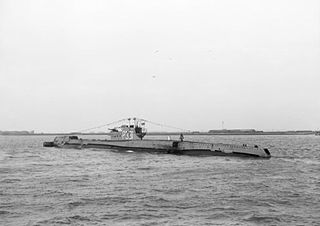
HMS Trenchant (P331) was a British T class submarine of the Second World War built at Chatham Dockyard.

HMS Sportsman was a third-batch S-class submarine built for the Royal Navy during World War II. Completed in 1942, she spent most of the war serving in the Mediterranean Sea. After an initial patrol off Norway, she sank the heavy transport Général Bonaparte in the Mediterranean in 1943 and missed a French oil tanker. She was heavily damaged after a mistaken attack by an Allied bomber, and was sent east after repairs to participate in operations in the Black Sea. After the operation was cancelled, Sportsman patrolled the Aegean Sea, sending several Greek and German ships to the bottom. She sank the German transport SS Petrella in early 1944 despite it being clearly marked as a prisoner-of-war ship, killing 2,670 out of 3,173 Italians aboard. Sportsman sank several more ships, and suffered minor damage when she was detected and sighted while attempting to attack a convoy.

HMS Truant (N68) was a T-class submarine of the Royal Navy. She was laid down by Vickers Armstrong, Barrow and launched on 5 May 1939.

HMS Tigris was a T-class submarine of the Royal Navy. She was laid down at Chatham Dockyard and launched in October 1939.
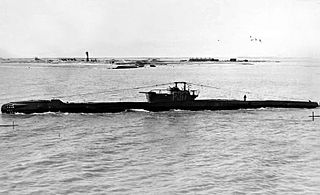
HMS Tally-Ho was a British submarine of the third group of the T class. She was built as P317 by Vickers Armstrong, Barrow and launched on 23 December 1942. She has been the only ship of the Royal Navy to bear the name, that of the hunting call, "Tally-Ho!".

HMS Terrapin was a British submarine of the third group of the T class. She was built as P323 by Vickers Armstrong, Barrow and launched on 31 August 1943. So far she has been the only ship of the Royal Navy to bear the name Terrapin, after the animal of that name. Apart from a brief period in home waters off the Scandinavian coast, Terrapin served in the Far East for much of her wartime career.
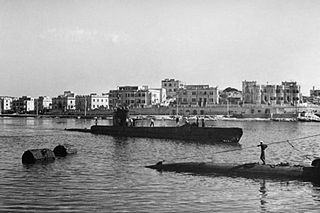
HMS Unruffled was a Royal Navy U-class submarine built by Vickers-Armstrong at Barrow-in-Furness. So far she has been the only ship of the Royal Navy to bear the name Unruffled.
German submarine U-65 was a Type IXB U-boat of Nazi Germany's Kriegsmarine during World War II. Over the course of six war patrols between 9 April 1940 and 28 April 1941, she sank twelve ships and damaged three others for a total loss of 88,664 gross register tons (GRT).




















